#1970s Architectural Digest
Photo

Zandra Rhodes’ London home
Architectural Digest, April 1978
#Zandra Rhodes#Architectural Digest#vintage Architectural Digest#70s Architectural Digest#1970s Architectural Digest#vintage architecture#70s architecture#1970s architecture#70s#1970s
70 notes
·
View notes
Text




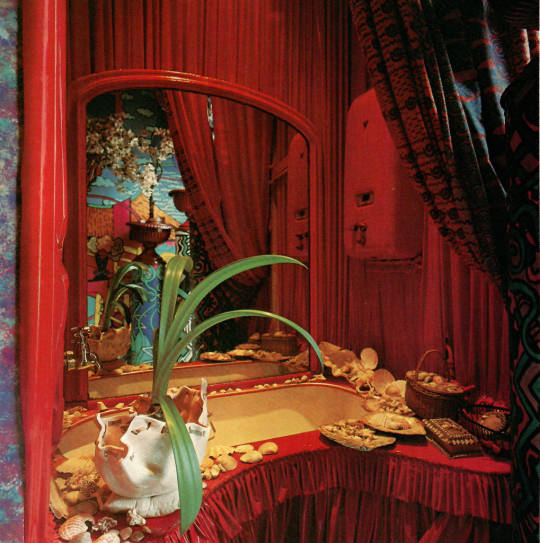

Zandra Rhodes' home tour
Architectural Digest, April 1978
Photographed by Derry Moore
#happy birthday#zandra rhodes#fashion#house tours#interiors#artist's home#architectural digest#1970s#derry moore#1978#bathroom#pattern#print#surface pattern#pattern design#surface pattern design#british designer
2 notes
·
View notes
Text
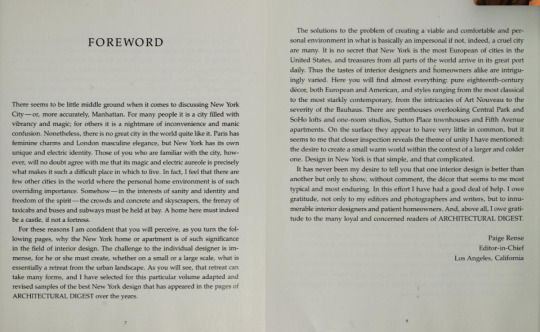
Foreword for Architectural Digest's New York Interiors (1979)
0 notes
Text




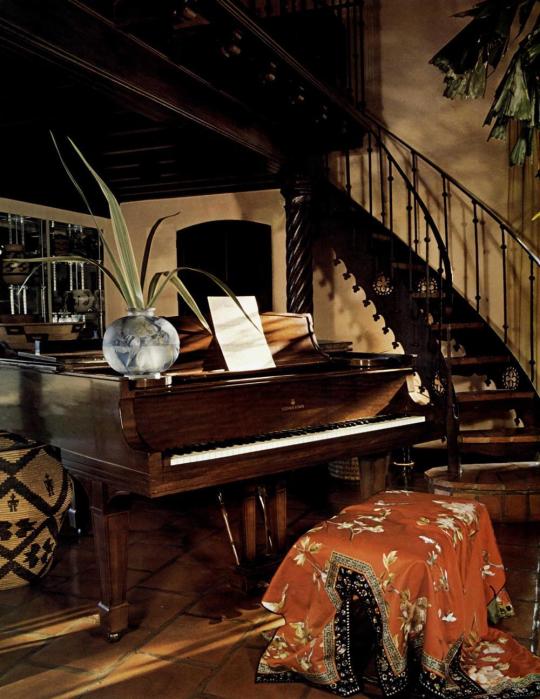





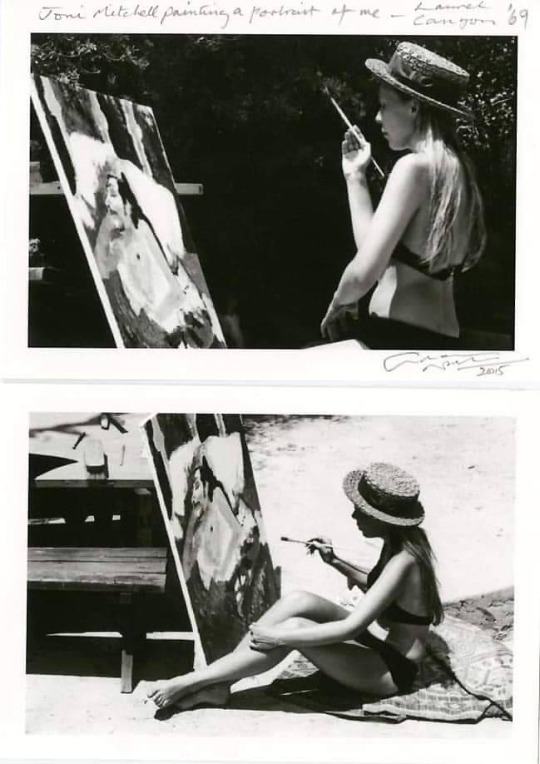


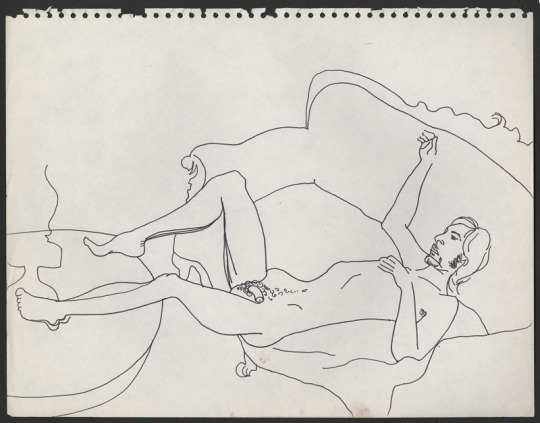















joni mitchell & graham nash
Morning Glory On The Vine: Joni Mitchell self-portrait / 1970s illustrations by Leslie Chapman / A Case Of You - Joni Mitchell / Joni painting a Graham Nash Nude at home in Laurel Canyon, 1969 / Comfort and Creative Living: Joni Mitchell’s House Architectural Digest July 1976 / Fireplace "Our House" Sketch by Joni Mitchell, 1969 / Far Out Magazine / Our House - csny / Morning Glory On The Vine: artwork by Joni Mitchell / Hannah Lock Illustration / Joni Mitchell painting Graham Nash, 1969 © Graham Nash / Graham Nash Nude Sketch by Joni Mitchell / Willy - Joni Mitchell / "Prayer" mpreg artwork of Graham Nash by Joni Mitchell / 1970s illustrations by Leslie Chapman / Joni Mitchell with Graham Nash writing her song for him “Willy” in a car on the way to Big Bear California, 1969 © Henry Diltz / Graham Nash interrupting Joni Mitchell painting a nude portrait of Nash, 1969 / Joni Mitchell playing guitar in Laurel Canyon / Joni Mitchell, Lookout Mountain in Laurel Canyon, 1969 © Graham Nash / Joni Mitchell's Art Studio, 2013 / Graham Nash in Laurel Canyon, 1969 © Joni Mitchell / Françoise Dorléac in Cul-de-sac (1966) / River - Joni Mitchell / Joni Mitchell, 1976 © Joel Bernstein
354 notes
·
View notes
Text
dakota johnson's architectural digest house tour had a more authentic 1970s color palette/filming style than this damn show
8 notes
·
View notes
Text
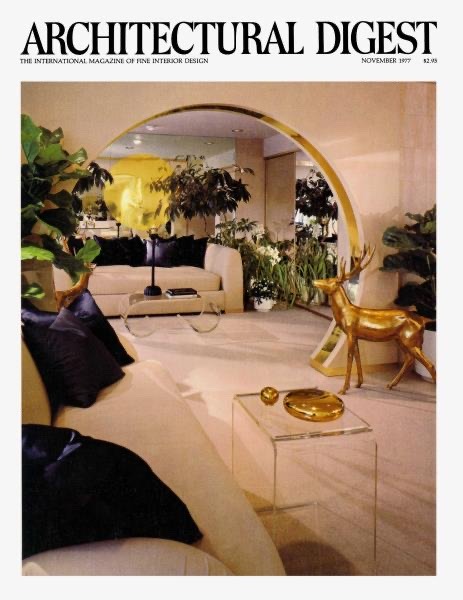
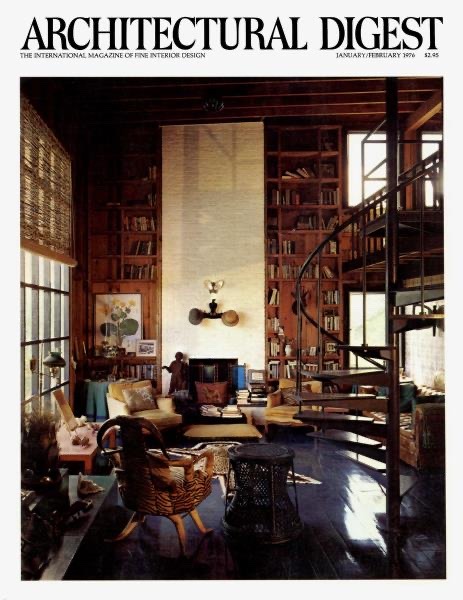
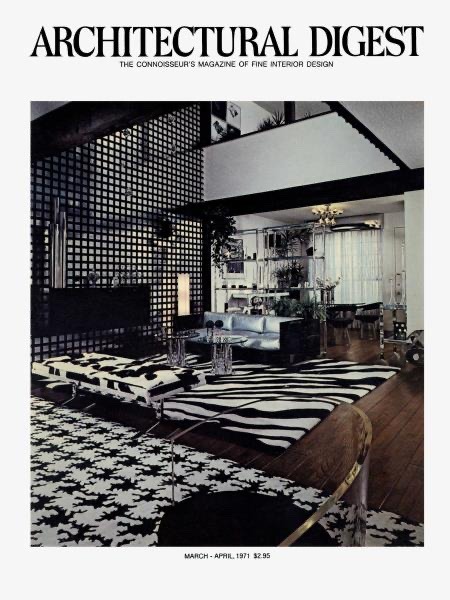
1970s Architectural Digest Covers via Architectural Digest
6 notes
·
View notes
Text
Cryptography’s three primary categories

Cryptography, from the Greek words meaning “hidden writing,” encrypts sent data so only the intended recipient can read it. Applications for cryptography are numerous. Cryptography is essential to our digital world and protects sensitive data from hackers and other cybercriminals, from WhatsApp’s end-to-end message authentication to legal form digital signatures to cryptocurrency mining’s CPU-draining ciphers.
One of the first cryptologists was Julius Caesar. Modern cryptosystems are more advanced yet work similarly. Most cryptosystems start with plaintext, which is encrypted into ciphertext using one or more encryption keys. The recipient receives this ciphertext. If the ciphertext is intercepted and the encryption algorithm is strong, unauthorized eavesdroppers cannot break the code. The targeted receiver can simply decipher the text with the correct decryption key.
Let’s start with robust cryptography frameworks’ key features:
Confidentiality: Only the intended recipient can access encrypted information.
Integrity: Encrypted data cannot be altered in storage or transit between sender and receiver without detection.
Non-repudiation: Encrypted information cannot be denied transmission.
Authentication: Sender, receiver, and information origin and destination are verified.
Key management: Data encryption and decryption keys (and related duties like key length, distribution, generation, rotation, etc.) are secure.
Three encryption types
Hybrid systems like SSL exist, although most encryption methods are symmetric, asymmetric, or hash functions.
Key symmetric cryptography
Symmetric key encryption, also known as private key cryptography, secret key cryptography, or single key encryption, employs one key for encryption and decryption. These systems need users to share a private key. Private keys can be shared by a private courier, secured line, or Diffie-Hellman key agreement.
Two types of symmetric key algorithms:
Block cipher: The method works on a fixed-size data block. If the block size is 8, eight bytes of plaintext are encrypted. Encrypt/decrypt interfaces usually call the low-level cipher function repeatedly for data longer than the block size.
Stream cipher: Stream ciphers convert one bit (or byte) at a time. A stream cipher creates a keystream from a key. The produced keystream is XORed with plaintext.
Symmetrical cryptography examples:
DES: IBM developed the Data Encryption Standard (DES) in the early 1970s. While it is vulnerable to brute force assaults, its architecture remains relevant in modern cryptography.
Triple DES: By 1999, computing advances made DES unsecure, however the DES cryptosystem built on the original DES basis provides protection that modern machines cannot break.
Blowfish: Bruce Schneer’s 1993 fast, free, public block cipher.
AES: The only publicly available encryption certified by the U.S. National Security Agency for top secret material is AES.
Asymmetric-key cryptography
One secret and one public key are used in asymmetric encryption. This is why these algorithms are called public key algorithms. Although one key is publicly available, only the intended recipient’s private key may decrypt a message, making public key cryptography more secure than symmetric encryption.
Examples of asymmetrical cryptography:
RSA: Founded in 1977 by Rivest, Shamier, and Adleman, the RSA algorithm is one of the oldest public key cryptosystems for secure data transfer.
ECC: ECC is a sophisticated kind of asymmetric encryption that uses elliptic curve algebraic structures to create very strong cryptographic keys.
One-way hash
Cryptographic hash algorithms convert variable-length input strings into fixed-length digests. The input is plaintext, and the output hash is cipher. Good hash functions for practical applications satisfy the following:
Collision-resistant: A new hash is generated anytime any data is updated, ensuring data integrity.
One-way: The function is irreversible. Thus, a digest cannot be traced back to its source, assuring data security.
Because hash algorithms directly encrypt data without keys, they create powerful cryptosystems. Plaintext is its own key.
Consider the security risk of a bank password database. Anyone with bank computer access, authorized or illegal, may see every password. To protect data, banks and other companies encrypt passwords into a hash value and save only that value in their database. Without the password, the hash value cannot be broken.
Future of cryptography
A quantum cryptography
Technological advances and more complex cyberattacks drive cryptography to evolve. Quantum cryptography, or quantum encryption, uses quantum physics’ natural and immutable laws to securely encrypt and transfer data for cybersecurity. Quantum encryption, albeit still developing, could be unhackable and more secure than earlier cryptographic systems.
Post-quantum crypto
Post-quantum cryptographic methods use mathematical cryptography to generate quantum computer-proof encryption, unlike quantum cryptography, which uses natural rules of physics. Quantum computing, a fast-growing discipline of computer science, might exponentially enhance processing power, dwarfing even the fastest super computers. Although theoretical, prototypes suggest that quantum computers might breach even the most secure public key cryptography schemes in 10 to 50 years.
NIST states that post-quantum cryptography (PQC) aims to “develop cryptographic systems that are secure against both quantum and classical computers, and [that] can interoperate with existing communications protocols and networks.”
The six main quantum-safe cryptography fields are:
Lattice-based crypto
Multivariate crypto
Cryptography using hashes
Code-based cryptography
Cryptography using isogeny
Key symmetry quantum resistance
IBM cryptography helps organizations protect crucial data
IBM cryptography solutions offer crypto agility, quantum-safety, and robust governance and risk policies through technology, consulting, systems integration, and managed security. End-to-end encryption tailored to your business needs protects data and mainframes with symmetric, asymmetric, hash, and other cryptography.
Read more on Govindhtech.com
#technology#govindhtech#technews#news#cryptography#symmetric cryptography#ibm#Post-quantum cryptography#Asymmetric-key cryptography#One-way hash#Quantum computing
0 notes
Text
Best Anniversary Balloon Dubai From Balloon Zone!
Balloons represent a part of childhood that can never be lost: the thrill of discovery, exploration, and play. For whatever reason, people all across the world equate balloons with parties, festivals, and other celebrations. Balloons, however, provide a wide range of other functions, such as weather observation, drug distribution, and communication. Come to us right now for Anniversary Balloons Dubai.
An Outline of Balloon Culture
Animal bladders and intestines were fashioned into different shapes and left hollow or filled with air or water to be used as toys and other types of entertainment before rubber and plastic were employed in the construction of balloons.

The Aztecs would twist the digestive tracts of cats into the forms of other animals and then blow air into them as a gift to their gods. Asian cultures have been using lanterns for everything from military operations to celebrations since ancient times.In 1824, scientist Michael Faraday is credited with creating the first rubber balloon. Two pieces of rubber were glued together, and then hydrogen was added to the bag.
These hydrogen-filled balloons, he saw, rose effortlessly into the air. Almost immediately following Faraday's tests, balloon-making kits were made commercially available, but it wasn't until the late 1800s that ready-made rubber balloons were marketed to customers as toys.
In 1912, the first balloons in the shape of long sausages were made. The first latex balloons appeared in the 1920s, and by the 1930s, people were twisting them into all sorts of shapes for entertainment and marketing purposes.
In the 1970s, plastic foil balloons allowed for the first time the display of non-distorted photographs, pictures, and other graphics.In the 1980s, releasing a large number of fashionable balloons at once became a frequent habit.The pieces of a balloon that are carried by the wind will eventually come to rest on water and soil after the balloon itself falls to the ground.
Over time, people started to worry more and more about the trash left behind by balloon releases. Today, people have a better idea of how to play with balloons in a way that doesn't endanger the lives of animals without sacrificing the joy that comes with them.
Festivities Featuring Balloons
Balloons are a common way to mark special events like birthdays, games, and festivals. Furthermore, they are used to commemorate significant life events like weddings and memorial services for departed loved ones.
Balloon artists frequently produce three-dimensional masterpieces like sculptures, architectural elements, and fantastical animals. Welcome arches and balloon walls are common decorative elements at weddings and other parties.
Balloon painters may often twist balloons into the shapes of well-known cartoon characters or bizarre animals with the purpose of entertaining children. Balloon releases are common at corporate events such as store openings and the debut of new items.

Concerts and other public events often feature balloon drops because they are a more environmentally friendly alternative to traditional balloon releases. Inflated balloons are enclosed in a net and hoisted at a great height over the target area. The moment they are released from the net, they float to the ground, where excited bystanders are waiting to grab them.
I've never understood the significance of balloons at children's birthday parties. Because they are fun to watch, cheap to buy, and nice to look at. Balloons are enjoyable, simple to produce, and cheap additions to any celebration's decor or party favors. Balloons are essential for a grand celebration. Balloon Zone is here to assist you in all of your balloon needs for your upcoming birthday party. Using helium-filled balloons instead of the regular kind.
Balloon Zone creates custom balloons for any event, big or small, celebratory or corporate. Our graphic designers will work with you to make one-of-a-kind balloons in a wide range of sizes and colors, complete with custom text, graphics, and even forms. Contact Balloon Zone as soon as possible to learn more about how the addition of Bubble balloons Dubai may add to the celebration of your upcoming event.
0 notes
Photo

Zandra Rhodes’ London home
Architectural Digest, April 1978
#Zandra Rhodes#architectural digest#vintage architectural digest#interiors#vintage interiors#70s interiors#1970s interiors#vintage interior design#70s interior design#1970s interior design
257 notes
·
View notes
Text

7 notes
·
View notes
Text
Everything You Need to Know About Lionel Richie's Residence
Lionel Richie is a huge admirer of today's music singers and would be a fantastic judge on the forthcoming American Idol. While he has been off the program for a few years, his admiration for today's music artists is evident. Consequently, he'll join Katy Perry and Luke Bryan on the judging panel.
Lionel Richie is an American singer-songwriter born on June 20, 1949, in Tuskegee, Alabama. His sweet love ballads from the 1970s and 1980s are his most well-known works. Richie is a skilled artist whose music covers numerous genres.
Richie is atop the Billboard Artist 100 list, and his new live CD Hello From Vegas debuted at the top. It is Richie's sixth solo album to reach the Billboard 200 chart's Top 10. Adele, Future, and Frank Ocean are among the most recent solo artists to hit the Top 100. But Lionel Richie isn't satisfied with his achievements.
Richie's record has several duets with country singers such as Kenny Rogers. During the program, he and Rogers sang "Lady." Richie's songs were preceded by filmed vignettes of the performer discussing the music he'd be singing. Another video featured country performers performing in the studio with Richie.
Lionel Richie, a superstar composer, and producer, is among the most well-known names in the music business. He began his career with the Commodores and has since become a solo musician and a judge on American Idol. He is still writing songs and has a net worth of more than $200 million. In addition to his enormous riches, he owns one of Beverly Hills' most extraordinary properties.
Richie started singing in R&B ensembles as a student and went on to become the Commodores' lead vocalist. Richie was quickly signed to a contract with Motown Records after the trio released one album for Atlantic Records. His songs were successful, including "Brick House" and "Easy." He also composed music for Kenny Rogers.
Lionel Richie is a singer, record producer, and television judge. Lionel Brockman Richie, Sr. is his father. Since 2004, he has been on the American Idol judging panel.
Richie had a lengthy career in the music industry. He has starred in various music videos and received prizes and distinctions due to his achievement. Berklee College of Music earned him an Honorary Doctorate of Music in May 2017. In addition, he received the Kennedy Center Honors in December, with LL Cool J and Gloria Estefan. In 2017, he was also revealed as a judge on the reboot of American Idol. He has since featured in other episodes.
Richie's most notable hit was his 1984 track "Hello," a sweet love tune. It was Richie's first top 10 hit, and he went on to have a successful career in music. That year, he had three more top 10 hits. Later, he produced Diana Ross's song "Missing You."
An excellent piece about Lionel Richie's house was published in Architectural Digest. The house had 28 rooms when it was first completed in 1929. Richie has spent millions of dollars personalizing the inside, which has undergone multiple modifications. It has a zen rose garden, expansive terraces, and a spa.
Richie grew up in Tuskegee, Alabama, and attended Tuskegee University. His mother was a teacher, while his maternal grandmother taught music. He also has an uncle who was a Duke Ellington arranger. His uncle also handed him his first saxophone. He had pondered becoming an Episcopal priest before beginning his profession. However, he was drawn to the young ladies who sang at prom and abandoned his plans to become a priest.
Richie has been on American Idol five times and has won several accolades. He is glad for the chance to influence the next generation of artists. Furthermore, being a performer, musician, and producer, he brings a distinct viewpoint to the program. As a consequence, he adores today's pop stars.
Michael Jackson's pal, Lionel Richie, suspected something was wrong with the King of Pop. He blamed Jackson's strange conduct on the bright lights of stardom. Richie even went so far as to attempt to reason with the King of Pop. Michael Jackson, on the other hand, died in 2009 from an accidental overdose of prescription drugs.
Richie was horrified and grieved by Jackson's death. As a consequence, he struggled to accept his idol's demise. He was, however, just 65 years old at the time.
0 notes
Photo
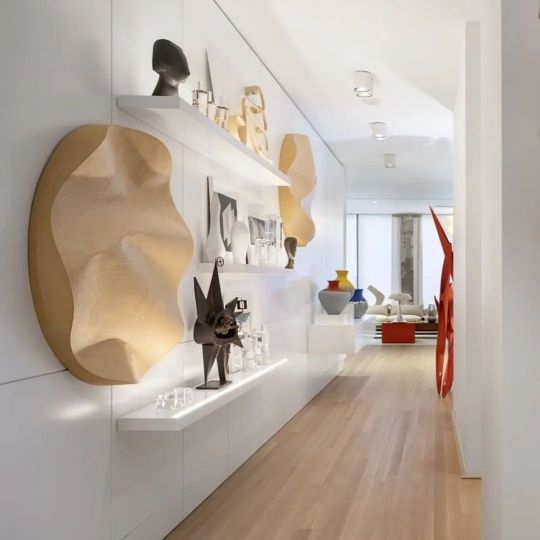
Je suis subjuguée par cet appartement ce matin et je ne me suis pas trompé imaginez il a été le .Gagnant du prix Best of Year 2019 @interiordesignmag . Lauréat du prix de l'architecture américaine 2019 @thechicagoathenaeummuseum .Lauréat du prix NYCxDesign 2018 - Meilleur appartement Il est l'œuvre du cabinet d'architecture New Yorkais Shelton Mindel & associates #Repost @sheltonmindel “The flow of space creates the perfect setting for Mindel’s collections. At the entry, you’re met by an Ai Weiwei bicycle sculpture and a table by Zaha Hadid. The “gallery,” a corridor to the living/dining/kitchen space, is lined with more art [...]” Published in Architectural Digest April 2019, “Inside AD100 Architect Lee Mindel’s Statement-Making Apartment” Indoor/Outdoor Sculpture Garden - 56 Leonard in collaboration with Jose Marty Aalto Tank Chair Rik Magnussen rare 'Yoga' chair and footstool, original leather Pratesi Bedding DWR night table Vintage French table lamp, 1970s Perforated Sculpture by Marc Fornes @theverymany Winner of 2019 Best of Year Award @interiordesignmag Winner of 2019 American Architecture Award @thechicagoathenaeummuseum Winner of the 2018 NYCxDesign Award - Best Apartment Photography by @mmoranphoto @leemindel @sheltonmindel #ad100 #elledecoralist #56leonard #leemindel #sheltonmindel #design #architecturaldesign @archdigest @archidgestpro #archdigestpro #adpro @cappelliniofficial @chilewich @paola_lenti_official @designwithinreach @56leonard https://www.instagram.com/p/CirkuRsMtoD/?igshid=NGJjMDIxMWI=
#repost#ad100#elledecoralist#56leonard#leemindel#sheltonmindel#design#architecturaldesign#archdigestpro#adpro
0 notes
Text
Week Five - Artist Research
Jon Barlow Hudson (b. 1945 USA)

Jon Barlow Hudson 'Double Helix' (2008). Stainless steel. 2.4m high and 2.4m wide and 7.5m
Image: https://rs.wescover.com/c_limit,f_auto,q_auto:eco,w_500/v1/wescover-user-uploaded/gbcki8cbfvzjo0d5jqqc

Image: http://www.hudsonsculpture.com/sculpture_usa/double_helix_sculpture_1.html
Jon Barlow Hudson is an American sculptor who designed two large sculptures for the World Expo 88, held in Brisbane.
He works with a multitude of materials for his works including steel, stone, glass, copper, bronze, water and light.
His work 'Double Helix' is displayed outside the Diggs BioScience Building at Wright State University, Dayton, Ohio. It is made up of 38 stainless steel dodecahedra (a 10 sided prism) welded together in two independent strands.
It is large enough to walkthrough and is a figurative depiction of a Double Helix strand, related to genomics, it is the physical structure of DNA. In relation to the site, the sculpture correlates directly to BioScience.
Hudson's use of identical dodecahedrons creates a repetition of design as it curls along its plane. The stainless steel is polished in a circular manner which also lends to the stylised twist of a double helix.
The negative space between the helix provides an interval between the two strands and the tail ends supporting the weight of the work give balance to the large structure.
The scale of the work is 2.4m high and 2.4m wide and 7.5m in length.
References:
Website: http://www.hudsonsculpture.com/sculpture_usa/sculpture_usa.html
Website: https://www.sculpturecenter.org/oosi/items/show/1506
Tudor, W. (1998). Jon Barlow Hudson: Standing Firm in Ritual. Iss 21(2). P 38. Columbus: Dialogue Inc.
Siavash "Siah" Armajani (b. 1939 Iran, d. 2020 USA)
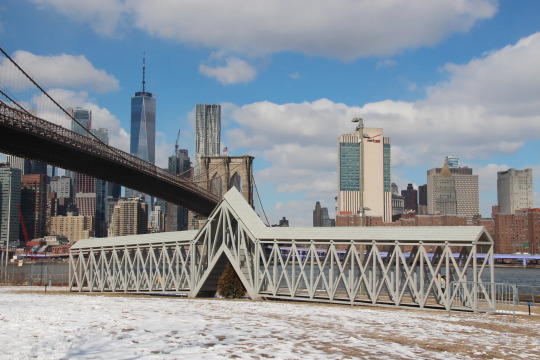
Bridge Over Tree (in Brooklyn, NY) (1970). Timber and shingles. 27.3 metres long.
Image: https://media.architecturaldigest.com/photos/5cfec0bbb451b3bf601addbc/master/w_1920%2Cc_limit/GettyImages-1128984358.jpg
Siavash "Siah" Armajani is an Iranian-born American sculptor, he is well known for his outdoor sculptures.
His work 'Bridge Over Tree' was installed in Minneapolis in 1970 and not again until 2019 in New York. It is constructed of timber trusses and a shingled roof and has a set of stairs in the centre that crosses over the top of a small evergreen tree.
The sculpture was designed to force complete strangers to pass, interact, and cooperate with one another when passing the centre of the structure.
The stairs come to a point, with no landing and so this means that those climbing the stairs will need use of both their arms and legs to commandeer it.
The repetition of the cross barred trusses creates a look of uniformity and safety. The structure appears solidly built and provides safe passage.
The interruption of the point on the walkway creates an interval for the design, a pause in its continuation, and certainly a point of interest with the evergreen tree beneath it.
The site here is significant as the work was only ever once on display and at the time in 1970, it was not seen as a work of art.
This prominent location for Armajani in Brooklyn, NY means that the work will be passed through and appreciated by hundreds of thousands of people.
Its physical construction also mirrors some elements of the other bridges located in New York City and the work assimilates well into this environment.
References:
Website: https://www.publicartfund.org/exhibitions/view/siah-armajani-bridge-over-tree/
Website: https://www.architecturaldigest.com/gallery/11-most-fascinating-public-sculptures
Masters, H. (2020). Siah Armajani. Iss15. P66. Art AsiaPacific Almanac.
McGrath, K. (2019). Siah Armajani Restages His Seminal Political Work at the Base of the Brooklyn Bridge. Architectural Digest.
0 notes
Photo

Liang Luscombe
Malamadre
Saturday, July 30, 8PM
Join us for the Chicago premiere of Liang Luscombe’s new short film, the science fiction extravaganza Malamadre (2022). Taken from the Spanish word for the ‘bad mother’ spider plant, Malamadre is the latest work in Luscombe’s ongoing surreal comedy series that follows Sol and Fran on their intergalactic odyssey away from the financial horrors of Earth and towards the planet Howl.
Opening with a sickly Fran and a hangry alien puppet Alice, the film immediately casts doubt on the promise of Howl as a utopia. What Fran finds instead is a strange matriarchal world of asexual reproduction where mothers feed on their young. Will Fran reckon with her maternal fears and finally enjoy a symbiotic alien relationship? Moreover, will she make use of the planet’s five hundred beaches before they close at 5pm?
To set the stage for Malamadre, the evening will be begin with three short films that also circle on the theme of the monstrous mother and the femme body as a site of complex meaning: Claire Lambe’s I Think I’m turning into a Monster (2021), Ilana Harris-Babao’s Decision Fatigue (2020) and Lucy Beech’s Reproductive Exile (2018).
Liang Luscombe’s practice encompasses painting, sculpture, and moving image that engage in a process of questioning how images and film affect audiences. She received her MFA at Virginia Commonwealth University, USA. She has been included in screenings at ACMI, Melbourne; Composite, Melbourne; Liquid Architecture, Melbourne; AceOPEN, Adelaide; MetroArts, Brisbane; OpenTV, Chicago; Comfort Station, Chicago; and Vehicle, NYC. She has undertaken residencies at Chicago Artist Coalition’s HATCH residency program, Chicago, 2019; SOMA Summer, Mexico City, 2018; Australia Council Studio, British School at Rome, 2013; and Perth Institute of Contemporary Art Studio Residency, Perth, 2011.
Ilana Harris- Babou’s work is interdisciplinary; spanning sculpture and installation, and grounded in video. She speaks the aspirational language of consumer culture and uses humor as a means to digest painful realities. Her work confronts the contradictions of the American Dream: the ever unreliable notion that hard work will lead to upward mobility and economic freedom. She has exhibited throughout the US and Europe, with recent survey exhibitions at Kunsthaus Hamburg, Germany & the ICA Chattanooga, USA. Other venues include The Whitney Museum of American Art, New York, USA; The Studio Museum in Harlem, New York, USA; Kunsthal Charlottenborg, Copenhagen, Denmark; and West Space, Melbourne, Australia.
Melbourne-based artist Claire Lambe draws from film, music, and traditional sculptural practice to create psychologically complex spaces that invite speculation on the human body as both matter and intermediary. Raised in Macclesfield, North of England in the 1970s, Lambe acknowledges the complexity of leaving, a probing flirtation between transformation, hostility, and tenderness. Lambe trained as a traditional sculptor, and holds degrees from Bristol College of Art, Bristol, United Kingdom; University of New South Wales, Collage of Fine Arts, Sydney; and Goldsmiths, London, United Kingdom. Recent major exhibitions include, The Body Electric, National Gallery Australia, Canberra, curated by Shaune Lakin and Anne O'hehir in 2020; From Will to Form, Tarrawarra Biennale, curated by Emily Cormack in 2017; and Mother holding something horrific, Australian Centre for Contemporary Art, Melbourne, curated by Annika Kristensen and Max Delany in 2017. Lambe was awarded the Australia Council, ACME International Residency, London, United Kingdom, 2018; and the Edwards Trust award, ISCP, New York, USA, 2015/2016.
Lucy Beech is an artist whose practice encompasses filmmaking, writing, and performance. Her current research project focuses on the social, cultural, and ecological implications of managing reproduction. Forthcoming and recent presentations of Beech’s film and performance work include MADRE—Museo d’Arte Contemporanea Donna Regina, Naples; SALT Beyoğlu, Istanbul, in collaboration with Cooking Sections and Kunstverein GartenHaus Vienna (all 2021); Biennial Matter of Art, Czech Republic (2020); Extra City Kunsthal, Antwerp (2019); Lafayette Anticipations, Paris; Tramway, Glasgow; De La Warr Pavilion, Bexhill-on-Sea (2018); Tate Britain, London (with Edward Thomasson 2017); and the Liverpool Biennial (2016).
1 note
·
View note
Photo
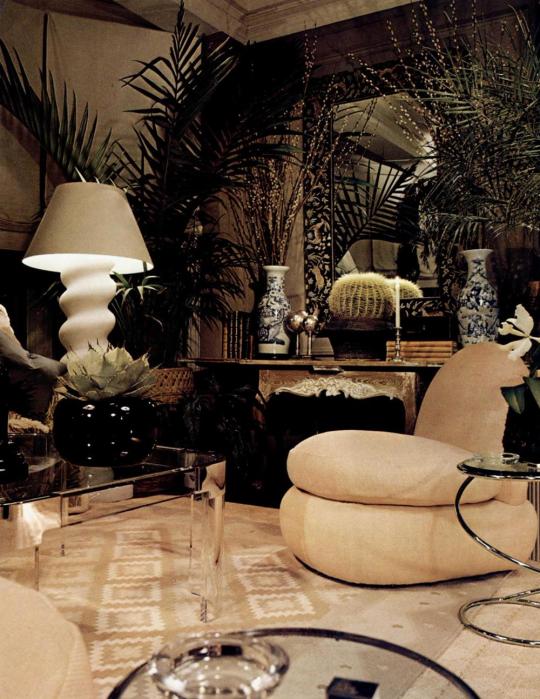
Anthony Machado - Architectural Digest, March 1976
#1970s interiors#1970s#interior design#interior decorating#1970s interior design#anthony machado#architectural digest#pace collection
905 notes
·
View notes
